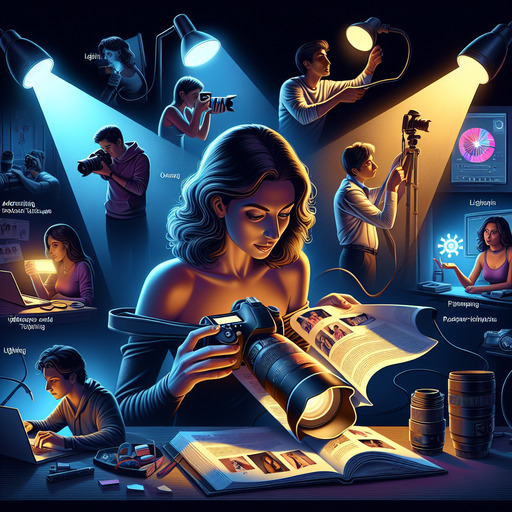
-
Table of Contents
- Mastering Photography: Tips and Techniques for Stunning Shots
- Understanding the Basics of Photography
- Why Mastering the Basics Matters
- Case Study: The Impact of Lighting on Portrait Photography
- Advanced Photography Techniques
- Exploring Creative Photography Techniques
- Real-World Example: Landscape Photography Techniques
- Editing and Post-Processing
- The Role of Editing in Professional Photography
- Case Study: The Power of Post-Processing in Portrait Photography
- Choosing the Right Photography Gear
- Investing in Quality Equipment
- Example: The Importance of Lenses in Landscape Photography
- Conclusion
- Questions and Answers
Mastering Photography: Tips and Techniques for Stunning Shots
Photography is more than just capturing moments; it’s about telling stories through images. Whether you’re a budding photographer or a seasoned professional, understanding the nuances of photography can elevate your work to new heights. In this guide, we’ll explore essential photography tips, techniques, and insights to help you capture breathtaking images.
Understanding the Basics of Photography
Why Mastering the Basics Matters
Before diving into advanced techniques, it’s crucial to have a solid grasp of the fundamentals. Understanding the basics of photography lays the foundation for more complex skills.
- Exposure: Learn how to balance aperture, shutter speed, and ISO to achieve the perfect exposure.
- Composition: Master the rule of thirds, leading lines, and framing to create visually appealing images.
- Lighting: Explore natural and artificial lighting techniques to enhance your photos.
Case Study: The Impact of Lighting on Portrait Photography
Consider the work of renowned portrait photographer Annie Leibovitz. Her ability to manipulate lighting has resulted in iconic images that capture the essence of her subjects. By experimenting with different lighting setups, you can add depth and emotion to your portraits.
Advanced Photography Techniques
Exploring Creative Photography Techniques
Once you’ve mastered the basics, it’s time to experiment with advanced techniques that can set your work apart.
- Long Exposure: Capture stunning nightscapes or smooth water effects by using long exposure techniques.
- HDR Photography: Combine multiple exposures to create images with a high dynamic range, revealing details in both shadows and highlights.
- Macro Photography: Discover the beauty of small subjects by using macro lenses to capture intricate details.
Real-World Example: Landscape Photography Techniques
Landscape photographer Ansel Adams is famous for his breathtaking black-and-white images of the American West. By using techniques like long exposure and careful composition, Adams was able to convey the grandeur of nature in his work.
Editing and Post-Processing
The Role of Editing in Professional Photography
Editing is a crucial step in the photography process, allowing you to enhance and refine your images.
- Software Tools: Familiarize yourself with editing software like Adobe Lightroom and Photoshop to adjust exposure, color balance, and more.
- Non-Destructive Editing: Use layers and masks to make reversible changes, preserving the original image.
- Consistency: Develop a consistent editing style to create a cohesive portfolio.
Case Study: The Power of Post-Processing in Portrait Photography
Photographer Lindsay Adler uses post-processing to enhance her portraits, adding a polished and professional finish. By carefully adjusting skin tones and contrast, she creates images that are both natural and striking.
Choosing the Right Photography Gear
Investing in Quality Equipment
While skill and creativity are paramount, having the right gear can significantly impact your photography.
- Cameras: Choose a camera that suits your needs, whether it’s a DSLR, mirrorless, or compact model.
- Lenses: Invest in high-quality lenses to expand your creative possibilities.
- Accessories: Consider tripods, filters, and lighting equipment to enhance your photography.
Example: The Importance of Lenses in Landscape Photography
In landscape photography, wide-angle lenses are often preferred for capturing expansive scenes. Photographer Galen Rowell used wide-angle lenses to create dynamic compositions that draw viewers into the landscape.
Conclusion
Photography is a journey of continuous learning and experimentation. By mastering the basics, exploring advanced techniques, and investing in quality gear, you can elevate your photography to new heights. Remember, the key to stunning images lies in your creativity and passion for the art.
For more insights into photography, check out this comprehensive Wikipedia page on Photography.
Questions and Answers
Q1: What is the best camera for beginners?
A1: For beginners, a DSLR or mirrorless camera with manual controls is ideal. Models like the Canon EOS Rebel T7 or Sony Alpha a6000 offer a good balance of features and affordability.
Q2: How can I improve my portrait photography skills?
A2: Focus on mastering lighting techniques, experimenting with different compositions, and engaging with your subjects to capture genuine expressions.
Q3: What editing software is recommended for photographers?
A3: Adobe Lightroom and Photoshop are industry standards for photo editing, offering powerful tools for enhancing and retouching images.
If you’re interested in learning more about photography or our services, please contact us.